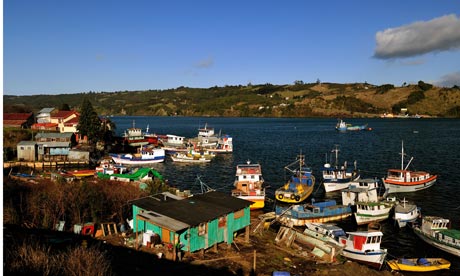
]The horse I hired was knackered and nameless, the chicha apple brew knocked me sideways, and I caught scabies in a cheap hotel. But I remember my week in Chiloé as one of the happiest of my life. After the buzz of the South American mainland, I found on these Pacific islands a temperate wilderness of misty pastures, 3,000-year-old alerce forest, and a very particular people who cherish their geographical isolation.
Two-thirds of the way down Chile's long, rugged coastline, the 40 or so small islands of Chiloé are seldom visited by the mainland population. The archipelago is celebrated for its damp climate and high rainfall (residents of the capital Santiago make jokes about Chilotés having webbed feet). But I was lucky. The sun shone for seven days. One afternoon, on the north coast of Isla Grande de Chiloé, the largest island in the group, the horse and I stopped at Ancud Bay. He stamped his arthritic legs while I watched flocks of oyster catchers and silvery grebe skimming the shallows. On the Patagonian horizon to the east, Andean volcanoes stood flat against an enamelled sky.
"We are not Chilean," a farmer's wife told me at Ancud market. "Estamos Chilote, no mas." There was no nod to the Americanised cuisine of Santiago. For the entire week I lived off milcao, grated potato patties cooked in pork fat. Heaven.
I didn't do much – just rode between flophouses of the $1-a-night variety, and drank chicha, the robust cider much loved in the interior. (It took my mind off the itching.) The plots of subsistence farmers harlequinned the land. Single churns were left to be collected at the end of lanes. The peaty light of fuchsia thickets and woodland held a stillness that had vanished from the mainland.
Mountains wall off the exposed west coast of Isla Grande, a re-emergence of the coastal cordillera of Chile which sinks into the ocean somewhere south of Santiago. At Duhatoa, the last beach before the road ran out, the horse and I trekked along the dromedary line of the dunes, beyond bamboo-like quila stands where nature outdid itself in elaborate fructification. But down in the unpeopled south-west, industrial logging was making deadly inroads into old-growth forest.
For 200 years, Chiloé marked the southern frontier of Catholicism. When the first conquistadores canoed across from the South American mainland in the third quarter of the 16th century, 400 horses swam alongside them. Their legacy (the Spaniards', not the horses') survives in 100 wooden churches carved by the golden hands of Chiloté craftsmen. The best carpenters were boat-builders, with the result that many churches look like upturned boats. At Colo, a village of three families, I sat on the low church wall to eat another chunk of pork fat. A pair of oxen swayed past drawing a sledge piled with timber. They were heading to the boat-building yard at Montmar. The ox driver sat next to me on the wall. He was 83.
"I suppose you've seen a lot of changes," I said, after we had chatted for a few minutes.
He thought for a while. "No tanto," he said – not so many.
• Last Frontiers (01296 653000) offers a seven-day trip to Chiloé from £2,147 per person. The price includes internal and international flights, a night in Santiago, a visit to a penguin colony, a boat/kayak trip through a "sunken forest", accommodation in a family farmhouse and a stilt village hotel, all activities and most meals
Sara Wheeler's latest book, The Magnetic North: Travels in the Arctic (Vintage, £8.99), is out now

